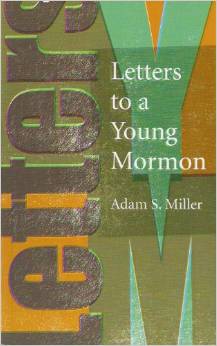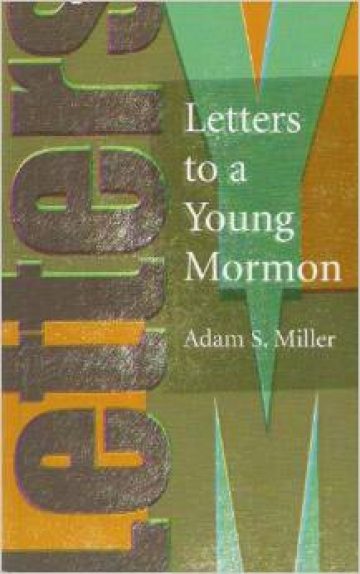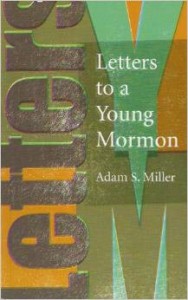I read Adam Miller’s Letters to a Young Mormon a bit ago, to the youngest Mormon I know well. (I think that she was six months, then.) I have been meaning to write a review since that time, but it is difficult to write well (or really, at all) about something so small that means something so big.
Because it is a personal book, perhaps I can begin personally: my Mormon heart has felt broken lately–by PR letter after PR letter, and the poor welcoming of women and men who should not have to fight to belong to the body of Christ. Miller’s words are some of the first to help unbreak it, because they are a reminder of everything good and beautiful in Mormonism. I am sincerely glad that my daughter has heard them, as I sincerely hope that she will hear them again, when she is young and old enough to take them in.
As the title suggests, the book is at least loosely inspired by Rilke’s Letters to a Young Poet. It is made up of twelve letters: Agency, Work, Sin, Faith, Scripture, Prayer, History, Science, Hunger, Sex, Temples, and Eternal Life. Each one begins, “Dear S.,” and ends, “Love, A.” Each is written to his daughter.
She and her younger siblings were held close in Miller’s mind as he wrote and struggled to “address the real beauty and the real cost of living a Mormon life.” While he noted in his introduction that the letters are intended “for a young Mormon who is familiar with Mormon life but green in their faith,” I believe that they may be fruitful for anyone. All can benefit from his one hope “to show something of what it means to live in a way that refuses to abandon either life or Mormonism.”
Miller fulfills this hope, by 1) writing with great thoughtfulness and great care (both of these things exude every page) and 2) by writing about simple topics simply and not simply, at the same time. What I mean by this may be best clarified by my favorite Dane, Søren Kierkegaard.
In his preface to Works of Love, he tells us that he is offering Christian deliberations in the form of discourses. A commentator noted, “In the same year in which he wrote Works of Love, Kierkegaard made an explicit contrast in his journal between a ‘deliberation’ and an ‘upbuilding discourse.’”
‘A deliberation,’ he says, ‘does not presuppose the definitions as given and understood; therefore, it must not so much move, mollify, reassure, persuade, as awaken and provoke people and sharpen thought.’ Whereas an upbuilding discourse about love ‘presupposes that people know essentially what love is,’ a deliberation ‘must first fetch them up out of the cellar’ and ‘turn their comfortable way of thinking topsy-turvy with the dialectic of truth.’
Deliberation here is to provoke some type of thinking in the individual, while discourse is a more settled definition. In Letters to a Young Mormon, Adam Miller may very well be offering Mormon deliberations in the form of letters. He provokes us to see, think, and live Mormonism differently. Such provocation should “awaken” (or begin to awaken) us to genuine Mormonism.
Neylan McBaine noticed the same thing. Her review likened Miller to
a Mormon C. S. Lewis, whose Mere Christianity or Screwtape Letters force Christians to reexamine all of the worn paradigms and rhetorics of our organized worship and instead inhale the pure essence of God’s glory.… Miller at once makes religion unknowable, ungraspable, while at the same time giving me the most concrete way to approach my faith that I have had for quite some time.
To illustrate, she pointed to my very favorite letter, “Prayer.” McBaine’s words on it are worth reading, as is the letter itself. I will add here, that Miller describes what happens when I try to pray more accurately than anything I have read before or since, through a deeply meaningful framing of forgetting and remembering.
When you pray, notice how the same thing happens almost every time. You address God and then you start to think about what you should say and then this prompts you to think about something else and then, caught up in thinking about this other thing, you forget that you were saying a prayer… Eventually, after a few minutes, you remember why you were kneeling there in the first place. This moment is the key. When, for the first time, you remember this, your prayer can start for real.
And,
The substance of prayer is this willingness to remember, to heave your wandering mind back, once more, in the direction of God, and then, when it drifts off again, to heave it still another time. To pray is it practice remembering God.
Still other letters talk about other simple things that we all know something about, but that none of us understands fully or completely. The letter on sin is (very much) less on the typical Sunday School definition and (very much) more on the stories we cling to, and the shadows we hide in, that hide us from God, who “doesn’t love [our] stories, he loves [us].” The letter on faith is on faithfulness and the kind of fidelity exercised in marriage, but it is also on doubting.
The letter on scripture is also on the work of translating, that Miller suggests we must shoulder alongside Joseph Smith. He “always expected more revelations, and ‘translation’ was one vital name for the hard work of receiving them.” As you translate, use everything.
The wider you read in Laozi, Shakespeare, Austen, Dogen, Plato, Dante, Krishna, Sappho, Goethe, Confucius, Tolstoy, and Homer, the better off you’ll be. …Don’t be afraid for scripture and don’t be afraid of these other books. Claim it all as your own. Doubtless, the world’s best books have their flaws, but this just means that they too must be translated.
I could go on and on, but will refrain.
One part of me wished very badly that there would have been a letter on Mormon feminist issues. One other part of me was grateful that there wasn’t. I am nervous that I won’t explain this very well, but its absence, and my knowledge that S., the book’s single individual, is a female, suggests that everything beautiful and expansive in it is for women, also, when right now, that is the good hope that I need.
Lastly, I am grateful that Miller most frequently referred to God as “God,” which lets me envision God as Heavenly Father and Heavenly Mother, as a united pair, and I am grateful for the theme of grace that permeates every letter.
Please read this book. Please read it to yourself, and the young (and old) Mormons that you know.
Love,
R
If you have read this book, which letter did you love best, and why?
If you have, or haven’t, read this book, what letters would you write to the young Mormons in your life (whether children, nieces and nephews, grand children, students, etc.)?







12 Responses
[…] As the title suggests, the book is at least loosely inspired by Rilke’s Letters to a Young Poet. It is made up of twelve letters: Agency, Work, Sin, Faith, Scripture, Prayer, History, Science, Hunger, Sex, Temples, and Eternal Life. Each one begins, “Dear S.,” and …read more […]
I also really loved this book – it felt like a beautiful new paradigm that I could cling to as I reorganize my faith in my head (and soul). I especially loved the chapters on History and Work.
Those are lovely (and important) ones. I wish that every member would read the History letter. It would help, I think.
This is the first I’ve heard of this book, and I will read it.
I am arrested by the phrase “the real beauty and the real cost of living a Mormon life.” As I grew up Mormon I only ever heard of the “blessings,” no one ever called it beauty, and no one ever acknowledged the costs. Were my teachers afraid that if they named the costs out loud I wouldn’t be willing to pay them? If so, they underestimated me. And that hurt because in naming blessings only, they told only part of the truth, and I knew it, without being able to quite realize what I knew.
Emily U., I am so happy to have introduced it to you. Please tell me when you read it.
I agree that framing the gospel only in terms of blessings isn’t complete, and it misses some very compelling bits. I love that your soul had that knowledge.
Thank you for reviewing this, Rachel! It sounds like a wonderful, thoughtful book — I just went to Amazon and ordered it.
I share with you some disappointment that he didn’t really address women’s issues in the book, particularly given the fact that this is aimed at his daughter. But I think you found a nice way of looking at that, Rachel. I might add a letter on “Family” or “Personal Revelation” or “God.” Though it’s very possible that Miller addresses all these things in gender inclusive ways in his other letters.
I heard about this book via Mormon Stories. It sounds like a good one to put on my “to read” list!
Ive not heard of this book, but is sounds powerful. I love the idea of a father writing letters to his daughter. As my father died when I was a teen, I think I would have absolutely loved it if there was something like this for me. Funny how something so simple is really something so grand, in many different ways to many different people. Thank you for highlighting this book for us!
I also LOVED this book. For all the years of my life I’ve given to Church attendance, there are so few words on any given Sunday that actually speak to my Mormon heart. Adam Miller ministers to that part of me in a way that has been very comforting me in the last few months as well. I’m so glad more people will find it through your beautifully written post, Rachel.
I’ve read the book now, and thought I’d return and report. I found the letters to be a fresh take on many things. I learned from this book. I’m grateful to you for telling me about it.
From the letter on Work, “Wanting love is good and wanting to excel is good. The trouble comes from trying to tie them together.” “Uncouple your desire to be loved from your desire to be great. Pursue love by striving to give it rather than possess it.” I thought that was beautifully said.
I also loved the chapter on Sin, how it wasn’t about bad deeds, but about preferring our stories about ourselves to God’s. “Faith isn’t about getting God to play a more and more central part in your story. Faith is about sacrificing your story on his altar.” This is one of the many things he says in the book that feels true to me, even if I can’t immediately think of a concrete way this would look in my life. I think this is why this book will speak to many people, because he uses a lot of metaphor. Though sometimes they strain the limits of what I can follow, for example. “[Guilt] recognizes that your shoes are too small and too tight and then blames your feet for their size. Repentance is not about shaving down your toes, it’s about taking off your shoes.” I’m not grasping that one.
At times the metaphors wax hyperbolic, and they left me feeling distant from the thing he is trying to get at. His introduction to Scripture is like that, and the letter on Prayer ends like that. And from the letter on Agency, “Do more than is asked of you, get up before your alarm sounds and work out your own salvation.” I think he’s using some hyperbole here to make a point, but it makes me feel exhausted and impossibly inadequate reading it. I try hard, I could try harder. How hard is hard enough? Do I need to push myself just shy of the point of irritability and collapse each day in order to be good enough? Because I feel I do this of the time, and I’m still not doing or being enough. But then he says “Working, you’ll find grace.” I believe that’s true; I depend on it.
I liked his idea of faith being more like faithfulness to a spouse than to believing in magic. “Whether God is or isn’t obvious to you, the work is the same: practice faithfully attending to the difficult, disturbing, and resistant truths God sets knocking on your door.” It’s interesting to me he doesn’t discuss faith as a spiritual gift. Instead faith is a kind of work. “Faith isn’t a way of going to sleep. It’s the work of waking up.”
From the letter on Temple, I like his saying the tree of life is a family tree, where God is the root and we are the branches. I’d never thought of it that way. It makes me feel some truth and goodness toward temple work, and I haven’t felt that in a long time.
I’m glad I read this little book, and I’ll be returning to it.
I love all of the parts that you loved, especially the beginning of “Work” and the whole part of “Sin.” I also think that your critiques are fair critiques. He does use many many metaphors, and some do work better than others, etc.
I’m so glad that you read it, and so glad that you’re glad about it.
[…] in Neal A. Maxwell Institute’s “Living Faith” series, with Adam Miller’s Letters to a Young Mormon being the first, Steven L. Peck’s Evolving Faith, being the third, and Patrick Q. […]